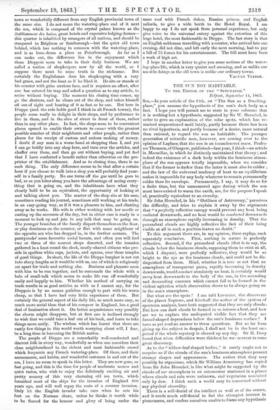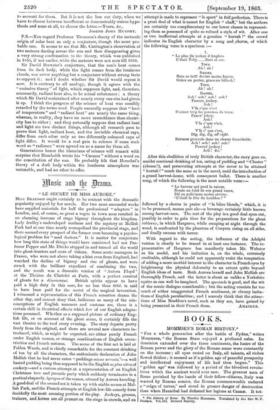THE SUN NOT HABITABLE.
To THE EDITOR OP THE "SPECTATOR."
Belfast, September 14, 1863. SIR,—In your article of the 12th, on "The Sun as a Dwelling- place," you assume the hypothesis of the sun's dark body as a fact. I hope you will permit me to state in your columns that it is nothing but a hypothesis, suggested by Sir W. Herschel, in order to give an explanation of the solar spots, which has re- mained unquestioned until lately, partly because there has been no rival hypothesis, and partly because of a desire, more natural than rational, to regard the sun as habitable. The younger generation of scientific men, however, are coming over to the opinion of Laplace, that the sun is an incandescent mass. Profes- sor Thomson, of Glasgow, published—last year, I think—an article in Macmillan, in which he distinctly maintained that theory ; and indeed the existence of a dark body within the luminous atmos- phere of the sun appears totally impossible, when we consider that if the former is darker than the latter it must also be colder ; and the law of the universal tendency of beat to an equilibrium makes it impossible for any body whatever to remain permanently colder than its envelope. Permanently, I say, it may do so for a finite time, but the unmeasured ages during which the sun must have existed to warm the earth, are, for the purpose I speak of, practically equivalent to an eternity.
Sir John Herschel, in his "Outlines of Astronomy," perceives the difficulty, and tries to explain it away by the arguments that "a perfectly reflective canopy would prevent any heat being radiated downwards, and no heat would be conducted downwards through an atmosphere rapidly increasing in density. That the penumbral clouds are highly reflective the fact of their being visible at all in such a position leaves no doubt."
To this argument there are, in my opinion, three replica, each
separately conclusive. First, nothing in nature is perfectly reflective. Second, if the penumbral clouds (that is to say, the clouds below the luminous clouds, supposing them to exist at all, which I dispute), were perfectly reflective, they would be as bright to the eye as the luminous clouds, and could not be dis- tinguished from them. Mind, whether it is true or not that an atmosphere of transparent gases, rapidly increasing in density downwards, would conduct absolutely no heat, it certainly would carry heat downwards to the body of the sun, in the ascending - and descending currents which cannot fail to be formed in the violent agitation which observation shows to be always going on in the sun's atmosphere.
But what are the spots ? I am told Leverrier, the discoverer of the planet Neptune, and Kirchoff, the author of the system of spectrum analysis, have both suggested that they are only clouds. But how can dark clouds be formed in so intense a heat, and how are we to explain the undisputed visible fact that they arc funnel-shaped depressions below the sun's luminous surface ? I have as yet read no answer to these questions. But so far from giving up the subject in despair, I shall not be in the least sur- prised if the whole mystery is cleared up any day. Sir H. Davy found that when difficulties were thickest he was nearest to some great discovery.
As to the " willow-leaf shaped bodies," it surely ought not to surprise us if the clouds of the sun's luminous atmosphere present strange shapes and appearances. The notion that they may possibly be organisms, which Sir William Armstrong has copied from Sir John Herschel, is like what might be suggested by the clouds of our atmosphere to an astronomer stationed in a planet where clouds and rain were unknown, and vegetation nourished only by dew. I think such a world may be conceived without any physical absurdity.
There is a self-denial of the intellect as well as of the senses, and it needs much self-denial to feel the strongest interest in phenomena, and confess ourselves unable to frame any hypothesis to account for them. But it is not the less our duty, when we have to choose between insufficient or demonstrably untrue hypo- thesis and none at all, to choose the latter.—Yours, JOSEPH JOHN MURPHY.
1'.S.—You regard Professor Thomson's theory of the meteoric origin of solar heat as only a conjecture, though the most pro- bable one. It seems to me that Mr. Carrington's observation of two meteors darting across the sun and then disappearing gives a very strong confirmation to the theory, which was published in 1855, if not earlier, while the meteors Were not seen till 1859.
Sir David Brewster's conjecture, that the sun's heat comes from its dark body, while the light comes from the luminous clouds, was never anything but a conjecture without strong facts to support is ; and I doubt whether Sir David would repeat it now. It is contrary to all analogy, though it agrees with the "emissive theory" of light, which supposes light, and, therefore, necessarily, radiant heat also, to be actual substances ; a theory which Sir David maintained after nearly every one else had given it up. I think the progress of the science of heat was sensibly retarded by the terms used. People naturally suppose that "heat of temperature" and "radiant heat" are nearly the same thing, whereas, in reality, they have no more resemblance than electri- city has to either ; and they naturally suppose that radiant heat and light are two distinct things, although all research goes to prove that light, radiant heat, and the invisible chemical rays, differ from each other only as two differently coloured rays of light differ. It would be a real gain to science if some such word as " radiance " were agreed on as a name for them all.
Generations hence the historians of science will remark with surprise that Humboldt wrote his " Cosmos " without a word on the constitution of the sun. He probably felt that Herschel's theory of a dark body within the luminous atmosphere was untenable, and had no other to offer.































 Previous page
Previous page